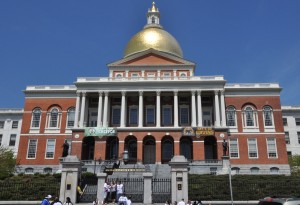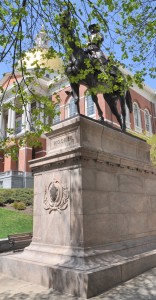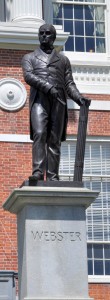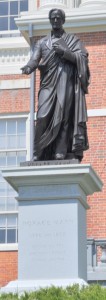
Since early childhood, I’ve loved government buildings. I spent a few minutes today in the sunshine outside the Massachusetts Statehouse.
***
In 1971, I began working for the State of Ohio. Part of my job required frequent trips to the Ohio Supreme Court, then housed in the Statehouse Annex. To get there, I walked through the rotunda of the Capital then out a side door across a very short walk and through the entrance to the Annex.
Like most public buildings, the Supreme Court’s had a pigeon problem. The birds liked to gather on the lintel above the entrance. The solution: a fence of spikes. Often, leaving the semi-darkness of the rotunda, what struck my eyes were a bright sun and an impaled bird, pigeons being pigeons.
That image comes much closer to capturing the justice system than a blindfolded woman improbably holding a scale and a sword.
***

The entrance to the Massachusetts Statehouse, I tell the gullible, is flanked by statues of a Hooker and a guy with his hand out. [Cue: knowing leer.]
Actually, the two statues next to the steps are the guy with his hand out (Horace Mann) and Daniel Webster. ‘One of the most immodest and immoral of the high Union commanders’, Maj. Gen. Joseph ‘Fighting Joe’ Hooker, sits astride his charger at the Hooker Entrance thirty feet to the east of the steps. ‘One of the most’ is most probably an understatement.
I’ve disliked Webster ever since a grade school English teacher inflicted ‘The Devil and Daniel Webster’ by Steven Vincent Benet. Webster was one of America’s great lawyer-politicians. But even then, I didn’t like the idea of a lawyer who could convince a jury of America’s greatest rogues and a Salem-witch-trial judge to release a man who’d sold his soul to the devil.
Much later after I got into socially responsible investing and corporate accountability research, I found my instincts were right.
His greatest piece of advocacy came in the Dartmouth College Case (1819). He convinced the US Supreme Court that a corporate charter was a private contract, not a unilateral granting of powers by government to a public entity. As a contract, the contracts clause of the Constitution kept states from modifying charters. From this utterly misguided decision has come our persistent problems with corporations.

In reality, Dartmouth College had little to do with principle and everything to do with protecting Federalist/Whig patronage jobs after the Democrats took office in New Hampshire. So Webster deserves his position in front of the Statehouse.
The man with his hand out, Horace Mann (1796-1859), doesn’t belong in this company. But, he did earn a statue on the Statehouse lawn.
Mann was the father of the American system of elementary and secondary education. He was also a highly successful state and federal legislator, a leading abolitionist and a college president. His position opposite Webster fits, since the two were opponents on the Compromise of 1850 and the Fugitive Slave Law.

What would Mann make of today’s public education in Massachusetts, with its charter schools and budget cuts? What would he make of UMass proposing to spend $6.9 million to join a Division I football league when the Legislature is proposing a $30 million cut to the University’s budget? Wrote the Boston Globe’s excellent Derrick Jackson:
There is nothing economically to recommend the move up. The Mid-American Conference may not spend as much as Oklahoma’s Big 12 Conference…. Still, according to a Knight Commission report last year, Mid-American Conference schools spend four times more on athletes ($48,000) than they do on other students ($12,000).
Actually, I have a good idea what Mann would think.
Recent Comments